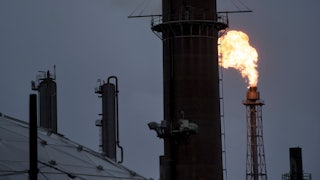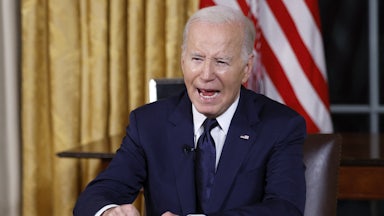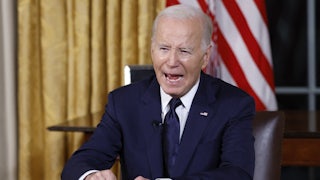In 1990, the Intergovernmental Panel on Climate Change released its first report on global warming—and by so doing started the clock on our collective response. In the three decades since then, humanity—as nations, peoples, and corporations—has spewed more carbon dioxide into the atmosphere than it had in all preceding history.
There are primarily three groups to blame for this depressing fact. The first is the fossil fuel cartel, which is to say the coal and oil and gas companies. It goes without saying that fossil capital, some of it “sovereign” capital owned and controlled by nations and some of it just straight-up private capital, has done everything to ensure that we remain dependent on fossil fuels for as long as possible.
The second is the global north. A huge percentage of both current and historical emissions comes from North America and Europe, with the United States responsible for twice as many emissions as any other country. Admittedly, the world has changed since 1990: China’s “emergence,” for example, lifted more people out of poverty than any other event in human history, though it also released immense plumes of carbon dioxide. These emissions get a lot of attention in the U.S., and deservedly so, but the poverty alleviation does as well. And the “developed” countries of North America and Europe still account for about a third of post-1990 emissions.
The third is the Global Rich. This, not China’s rise, is the story that’s most crucial if we want to understand why our poor efforts at mitigation have been such unrelenting failures. It is impossible to appreciate the forces at work behind the past three decades of emissions without recognizing how many of these emissions belonged to the rich.
Forget, for a moment, your national identity. Consider inequality from an astronaut’s perspective. Imagine the earth and all the suffering on it. Think globally, as if there were no countries or borders, but only one great planetary pool of humans, which can be partitioned into nations, or races, or genders, or ethnic and religious communities. Or into classes—like “the global one percent”—defined by wealth, income, and emissions.
This is the global inequality approach that multiple schools of activist scholars—the World Inequality Lab is prominent among them, as is the Stockholm Environment Institute—use to illuminate the workings of the climate challenge. Typically, they frame their results in terms of three great global classes—the top 10 percent, the bottom 50 percent, and the remaining 40 percent, who are often called “the global middle class.” In 2021, the top 10 percent held 76 percent of the world’s wealth, while the middle 40 percent held 22 percent, and the rest of the world held just 2 percent.
In this global inequality approach, one doesn’t compare the wealth of an average American to that of an average Chinese, or the emissions of an average Colombian to those of an average Russian. One ignores countries, at least initially, to reveal the bigger picture.
Global income distribution is significantly less polarized than wealth. The poorest half of humanity—the bottom 50 percent—enjoy a full 8.5 percent of global income, a dismal figure to be sure but still considerably more than their 2 percent of global wealth. Similarly, the world’s top 10 percent take 52 percent of the world’s total income, a figure that, while smaller than their 76 percent of total wealth, is still horrifying. And if you venture into the heights, where you find the top 5 percent, the top 1 percent, the top one-hundredth of the top 1 percent, you’ll see that the concentration of both wealth and income—and emissions as well—continue to intensify as you rise, in an almost fractal manner.
Because income and emissions are highly correlated, this approach allows us to better answer the question of why humanity’s cumulative emissions have doubled since the early years of the U.N. climate treaty. The Stockholm Environment Institute’s Carbon Inequality Era paper shows that, in the period since 1990, as emissions almost doubled, the rising consumption of the world’s top 10 percent was responsible for almost half of that increase—almost as much as the entire remaining 90 percent of the world’s population. The emissions of the richest 5 percent (37 percent of all post-1990 emissions) were particularly notable, and the emissions of the top 1 percent (who contributed 21 percent of all post-1990 emissions) were far greater still.
Many of us will live to see the consequences of this emissions growth, as the temperature begins a true overshoot (and not just a transient spike) above 1.5 degrees Celsius (2.7 degrees Fahrenheit). To have a 50/50 chance of holding the 1.5-degree line, we have to limit emissions from the beginning of 2023 onward to about 250 metric gigatons of carbon dioxide. At current global emissions levels, that budget will be exhausted in 2029. But the world’s richest 10 percent would exhaust it on their own by about 2035, even if the rest of us were to cease emitting anything at all.
The problem isn’t just that wealthy people generate more carbon emissions than poor people. It’s that the sheer overwhelming extent to which they do so belies the endlessly repeated claim that rising fossil fuel consumption and even the destabilization of the climate system are justified by the need to lift the world’s poor from poverty.
The truth is that the poorer, energy-deprived half of the human population has barely contributed to, and barely benefited from, these past three decades’ rise in emissions, during which the earth’s temperature has risen perilously. Rather, they continue to struggle, even as they’re pummeled by the devastations of an ever more inhospitable climate system.
Emissions injustice collides with climate reality in complex ways, all the more so because we do not inhabit an astronaut’s borderless world, with its stylized planetary classes. The real world is divided among nations, every one of which is internally stratified between rich and poor. In this twice-divided world, the culture and politics of global inequality form a tangle of confusing and invidious dynamics—in itself a barrier to climate stabilization, which requires an international politics that is at least rational, if not visionary. Neither will be possible until inequality and injustice become central to climate politics.
When the history of the climate reckoning is written, these current years will figure large in the tale. Indeed, the U.N. climate conference known as COP28, which will be held later this month in Dubai with Sultan Al Jaber of the United Arab Emirates—an oil executive from the global south—as its president, may well prove to be the pivot. A chill has come over the world’s elites in recent years as they gradually realize that today’s international governance system—with its parade of agonizingly compromised climate summits and its utter inability to establish a just and cooperative peace—may simply not be up to the challenge of climate stabilization.
Gordon Brown, the former British prime minister, is campaigning for a small international tax on oil and gas export revenue. William Ruto, the president of Kenya, is calling for a more ambitious package of reforms, including a tax on the international oil trade. (Unlike Brown, he is speaking for a group of countries, as per the common position negotiated at the Africa Climate Summit.) Mia Mottley, the prime minister of Barbados and a key voice in the new finance debate, has similarly called for new corporate climate taxes, among much else, and takes care to stress that “not just the oil and gas companies” are properly targets of such taxes.
What would happen if we started taxing the obscenely wealthy and their massive emissions as well? We have a pretty good idea of how this class and their emissions are distributed: Per the World Inequality Lab, about 46 percent of global 10 percent emissions come from North America, about 16 percent from Europe, and about 12 percent from China. If you focus on the global one percent, the numbers get still more skewed—North America clocks in at 57 percent, Europe at 15 percent, and China at 6 percent. Clearly, the global one percent still tend to live in the global north, which is good to know, although we shouldn’t forget the rest of those in the global 10 percent, regardless of where they live.
The protesters are demanding that we tax the rich, and I could hardly agree more. The best approach would be multilayered: In practice, a proper climate funding framework would involve not just progressive emissions taxes but straight-up wealth taxes as well, and all sorts of innovative financial instruments, from financial transaction taxes to new kinds of international shadow currencies (“special drawing rights”), as well as profound energy subsidy reforms (according to the International Monetary Fund, fossil energy is now receiving about $7 trillion a year in direct and indirect subsidies), large-scale debt forgiveness for struggling countries, and an international fair-shares assessment process that fills the gaps and ensures that the whole package is balanced and just.
But the centerpiece would ideally be global wealth taxes, which should be strongly linked to emissions. In his new book, A Brief History of Equality, French economist Thomas Piketty argues that we in “the egalitarian coalition” have “failed to produce a convincing alternative narrative” that shows how a “welfare state and progressive taxation do in fact constitute a system transformation of capitalism.” Constructing these alternative narratives, he argues, is a crucial gateway not just into a fairer future but also to global climate stabilization.
Piketty proposes instituting a progressive wealth tax, funding basic income, and supporting social welfare and environmental protection. “For starters, we can imagine, for example, a worldwide tax of 2 percent on fortunes that exceed 10 million euros, which would bring in considerable sums: around 1,000 billion euros each year, or 1 percent of global GDP,” he writes.
Obviously, such ideas won’t fit through the Overton window anytime soon. But many people have yet to grasp the severity of our predicament, and when they do (knock on wood), the window of imagined realism will expand. Piketty and many others are now anticipating such an expansion, and want to prepare for it with a global finance proposal that is explicitly scaled to both an emergency climate transition and the modern, planetary social democracy that, frankly, is a precondition for its success.
The alternative is clear enough: More ineffectual climate summits, episodic bursts of concerned rhetoric like the annual World Economic Forum in Davos, continued dithering by elites who are in fact responsible for many of the problems they say they want to solve. If we want to avoid such a fate, we’ll need a new kind of internationalism—call it emergency internationalism—that allows us to actually imagine a proper mobilization, at the necessary scale.
There is still time, but the clock is ticking.










